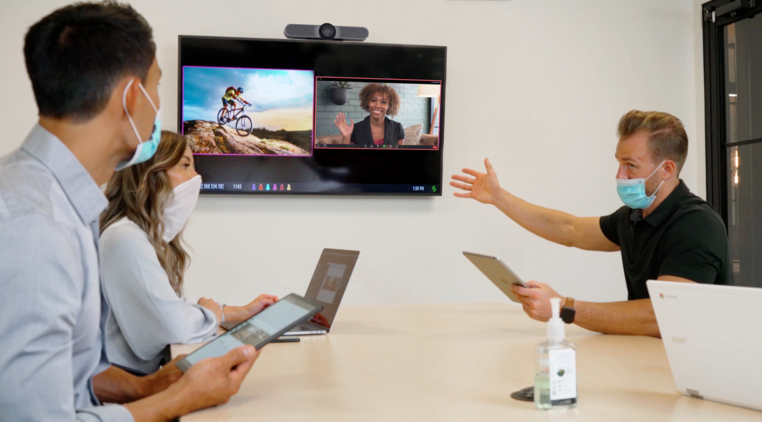
As this post is released, many around the world are in a second round of lockdowns or travel restrictions as COVID cases spike for a second time across many states and countries. Through it all, organizations and schools continue to look for ways to safely return their workers, students, and teachers to the workplace and classroom.
The hybrid model of mixed onsite and remote work and collaboration is beginning to shape not only how we view the current workplace and classroom situations, but also the technology and design for future meeting and learning spaces. While some degree of remote work is not a new concept, remote and hybrid environments will likely play a much more central role in the workplace moving forward.
What does this mean for collaboration?
Those of us who have been working from home for the better part of this year have become well versed in multiple video conferencing codecs. Video conference fatigue has also made many of us pine for the office – and in-person interaction – at least some of the time. We have all learned exactly what type of work we do well at home and when we would be more productive through in-person collaboration. Some of us would return to the office tomorrow if we could, while others are happy to continue plugging away from the comfort of their homes. And for many, a mix of both in-person and remote work is ideal. To support this new hybrid workforce, our meeting space technology must accommodate both onsite and remote participants.
Supporting Hybrid Workplace Collaboration
Video conferencing integration is a new, smarter room solution that unifies and enhances the collaboration experience among onsite and remote participants. By leveraging laptops users bring into the room, video conference removes the limitations of traditional room systems and sets the bar for a new class of Bring Your Own Meeting (BYOM) solutions.
Video conferencing integration provides conferencing support through our Solstice platform, extending all of the great collaboration features of Solstice with a user’s conferencing service of choice. What does this mean for end-users, technology administrators, and decision-makers? We’ve outlined the key advantages of Solstice Conference below.
Key Advantages of Solstice Conference
-
Convenience of a room system with the flexibility to use any conferencing service.
Solstice Conference seamlessly supports all major conferencing services, including Zoom and Microsoft Teams, to provide organizations with meeting room flexibility while avoiding vendor lock-in. By providing a touchless, one-step meeting start capability, Solstice Conference provides a hygienic meeting experience, while reducing the time and complexity needed to start a video conference. It works by wirelessly bridging USB room cameras and microphones to the meeting host’s laptop and allowing the meeting host to share the in-room display to the web conference. Unlike many console-based room systems, Solstice provides an easy-to-use workflow that is consistent across video conferencing services, reducing the need for additional training or support.
-
Improves the conferencing experience.
With rich, multi-participant content sharing and collaboration capabilities, Solstice Conference makes it easier for teams to effectively align and work together, regardless of their location. This collaborative environment differs significantly from the typical single-presenter meeting style of video conferences. In addition, Solstice Conference leverages user devices brought into the room, providing a touchless AV experience that avoids the need for shared dongles, room tablets, or control panels.
-
Smarter system architecture.
By utilizing only local networks for in-room content sharing, Solstice Conference enables local users to share high-quality, high-resolution content, such as 4k videos, without any external bandwidth costs. Compared to video conferencing solutions that route content through the cloud regardless of the meeting participant’s location, Solstice Conference reduces security vulnerabilities and increases local content streaming performance.
-
Fully leverages room audio and video.
Room audio and video devices, such as cameras, microphones, and soundbars, seamlessly integrate with Solstice via USB to deliver the full virtual communication experience and value of traditional room systems. Solstice Conference also preserves a device’s native functionality and certifications with conferencing services by transparently passing the audio/video streams to the onsite meeting host’s laptop rather than virtualizing the streams like other BYOM solutions.
-
Insights into workplace collaboration.
Video Conference includes access to Solstice Cloud Analytics, which provides organizations with broad-ranging, actionable insights into their Solstice-enabled spaces. With insights such as which conferencing services are most and least used, room occupancy and utilization, and proximate versus hybrid meeting split, organizations can measure how their workforce collaborates to help optimize and determine the ROI of their teamspaces and inform future budget decisions.
-
More affordable than traditional room systems.
Video Conference costs significantly less than traditional video conferencing room systems while providing a more collaborative meeting experience, as well as key capabilities beyond collaboration and conferencing support including management, analytics, digital signage playback, and more. In addition, Solstice Conference reduces hidden costs from external bandwidth consumption, vendor lock-in, and training/support.
-
No new hardware required.
Video Conference can be enabled with a simple software upgrade to an existing Solstice Gen3 Pod with a current Solstice Subscription. Unlike other BYOM solutions that require new hardware, Mersive’s software-based platform delivers this powerful new capability to existing customers at no extra cost.







As the modern workplace continues to see an increasing number of remote workers, organizations will need to prioritize collaboration solutions for the new hybrid workplace, leveling the playing field for onsite and remote participants. Solstice Conference delivers just that, with a rich collaboration experience for both onsite and remote participants. With agnostic conferencing support and an easy one-click start for all major conferencing services, Solstice is a smarter room solution that is both flexible and cost-effective.
Interested in Learning More?
See how Solstice works with Microsoft Teams and Zoom to deliver a better room solution.
